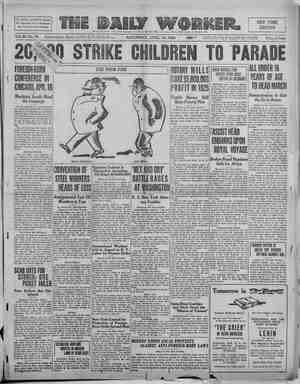The Daily Worker Newspaper, April 10, 1926, Page 8
You have reached the hourly page view limit. Unlock higher limit to our entire archive!
Subscribers enjoy higher page view limit, downloads, and exclusive features.
Nobody Home FS eeneen—. “ee -- Representatives of the Striking Passaic Textile Workers Went to Call on President Coolidge. Maurice-Becker, the Daily Worker Cartoonist, Shows Them Knocking on Mr. Coolidge’s Door. But Mr. Coolidge, Who Always Has Time to Meet Charleston Dancers and Jazz Singers—not to Speak of the Textile Millionaires—is too Busy a Man to See the Representatives of Many Thousands of Textile Workers in a Desperate Struggle for a Chance to Live. His Job as President of the Bigg: ’ By ROLAND A. GIBSON. hear a lot of talk nowadays among bourgeois “friends” of the labor movement, as well as from s0- called “labor leaders,” about the “so- cial ideals of labor.” Seldom are these ideals specified. There is much con- fusion in the minds of those who talk glibly about them and wide disagree- ment between those who advocate them. Even President Green himself is not too clear on the subject, but he is at least trying hard to make his ideals coincide with the most accepted and most respectable conceptions of social workers and humanitarian com- pany-inionists. Consider two choice paragraphs from Brother Green's address to the American Association for Labor Legis- lation on December 30, 1925: “Charitable organizations and friends of suffering humanity, thru the press and thru other mediums of communication, attract our attention to the ever-increasing number of peo- ple. who, suffer bodily pain and who are torn by the fangs of poverty. For these unfortunates assistance is Bosses, Not Workers. The Social Workers’ Ideal Is the = [deal of William Green sought and the public is asked to give generously and freely to alleviate their distressed condition. In keeping with the spirit of good will which pre- vails at this season the public answers the call of the needy in a most com- mendable way. Many who are hungry are fed. Many who are cold are clothed and made warm. Many who are sick are given medical attention. Homes, which have been dark, and. dreary are made cheerful, and bright with the laughter of happy. children. . “We may dream of a world without poverty and distress, but our dream can never be realized. The underlying causes of human euffering have al- ways existed and in all probability they will ever remain with humanity in some measure or degree. Human want and human woe can be traced to various causes, and I am confident that it is the will and the desire of society to remove the causes which make for human suffering and human distress, While we cannot attain the ideal by eradicating all causes of hu- man His we can deal with some of the causes from which our social ills originate in @ concrete and effective way. Chief among these are the so-;the. spirit of cial problems growing out of industry and inseparably associated with indus- trial development. In this category may be placed industrial accidents, child labor, unemployment, occupa- tional diseases, sanitation and indus- trial hygiene, There are other classi- fications which, while. important, are considered of a minor-character. All have their’bearing upon the main and ‘principal matters of interest.” There is meat for the social work- ers, Labor's spokesman praises philan- thropy. Unfortunately class collabora- tion has not yet perfected capitalism to the point where social ills will be largely eliminated. In fact, we must admit, says Brother Green, that these ills can never be eliminated. Poverty and distress are inevitable. True enuf, under capitalism! Nevertheless, President Green pays tribute to the millionaire philanthro- pists who, after obtaining their wealth out of the exploitation of the work- ers, do their little bit each Christmas season “to alleviate their distressed condition.” This is “in keeping with est Capitalist Republic is to Help goodwill.” Shades of Christ attest. ‘ Who is this “society” which Green says is pining “to remove the causes which make for human suffering and human distress?” The “public,” per- haps, which responds so commendably to the cries of starving children—once a year, Is it the government which refrains from interfering in these pet- ty matters? Or is it the proposed Har- mony Corporation, with ‘capital and la- bor as joint stockholders, that is go- ing to make the homes of all the work- ers “cheerful and bright with the laughter of happy children?” It would be hard to dope these birds out, if one were to give them credit ‘for possessing any knowledge about the real causes of the ills of capital- ism. But we know that they don’t pessess this knowledge, They do, how- ever, control the labor movement. That is why the militant workers must be on to their antics and prepare themselves to wrest control from the class-collaborationists and turn the la- bor movement into revolutionary channels. —_




